
[ad_1]
Samsung Galaxy A7 2018 detailed review
The year 2018 marked a tectonic shift in the way Samsung envisioned and marketed its mid-range phones. While the premium flagships, namely the Galaxy S series and the Note series continue to operate in the cutting edge, the mid-rangers have always lived under the looming shadows of them. Not anymore, though. Samsung Mobile’s head DJ Koh had declared that Samsung will bring never-before-seen innovation in phones. Little did we know his version of innovation is simply cramming more cameras on the back of the phone to bolster their chances of toppling the likes of OnePlus and Xiaomi, which have become its primary competition in India. Nevertheless, the Samsung Galaxy A7 arrived sporting not one, not two, but three cameras on the back. What was even more surprising is that the triple-camera setup was the first to arrive in a mid-ranger, instead of the flagship. It wouldn’t have been as surprising if it had been the other way round.
While there’s more to the Samsung Galaxy A7 (2018) than a triple-camera setup, Samsung’s marketing effort is primarily based around this feature. Naturally, our review focuses more on this aspect to see whether the heavy advertising about the triple-camera setup converts to usefulness. More than that, at a price point of Rs 23,990 and with compelling options like the Poco F1 and the Nokia 7 Plus, does it makes sense to buy the Samsung A7 (2018) instead? Let’s find out!
Design
The Samsung Galaxy A7 (2018), despite carrying new innovations in the form of a triple-camera setup, borrows a lot from its premium flagship siblings. A glass body and a Super AMOLED Infinity Display with an 18:9 aspect ratio, to be precise. But it’s nowhere as ergonomic as the Galaxy S9. Instead, it retains the wide form factor of the company’s earlier Galaxy C9 Pro with a taller and a slightly larger display, but with the same height. It’s not as curved as the Galaxy S phones which has curved edges and rounded corners to help grip the phone better. This one is table-flat. As a result, it was difficult for my tiny hands to reach the other end of the screen. One-handed use is out of the question and you have to put both hands to use to type out a message.
The shape aside, the Galaxy A7 (2018) feels pretty solid with a sturdy aluminum frame housing the glass body. There’s no flex whatsoever, but the delicate glass body makes me skeptical. Especially since Samsung didn’t mention about any Gorilla Glass protection. The phone does come with a transparent case out of the box, but that can protect the shiny body from scratches and smudges, but still leaves the display vulnerable.
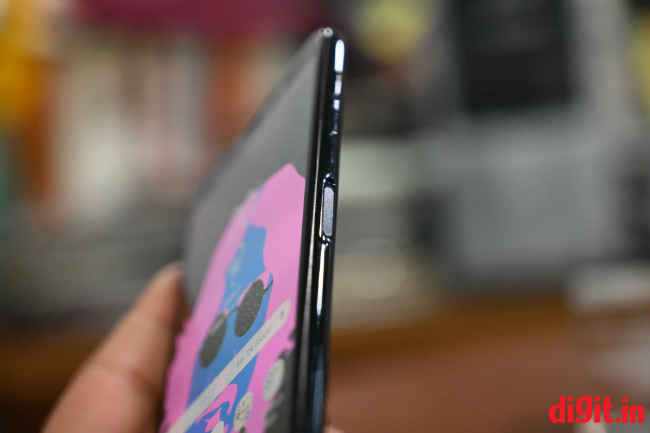
Fingerprint sensor now on the side, embedded in the power button
The Galaxy A7 (2018) is emboldened by Samsung’s decision to avoid the notch though. I’m good with having thin bezels around the screen over having to stare at a notch on a bright and vibrant display. The A7 (2018) also uses a micro-USB port for charging housed in the bottom. It is flanked by the endangered 3.5mm headphone jack and a tiny slit for the speaker. The phone’s left edge has nothing except the SIM card tray while on the right are the volume rockers and the power button with the fingerprint sensor embedded in it.
It’s another departure from the design Samsung had squared into in its flagships. But then, the placement of the fingerprint sensor has always been a controversial affair for the company ever since the Galaxy S8. Embedding it in the power button reduces the effort and it makes it more intuitive. Although coming from the Redmi Note 6 Pro, I kept reaching out to the rear panel out of muscle memory, but quickly got used to it. Even though it’s placed a little higher for me to reach naturally, the slight depression around th button makes it easy to find the button and the fingerprint sensor is quite responsive.
Many might feel the Galaxy A7’s design is a little outdated and for the most part, quite unwieldy, but it does make the phone classy and more expensive looking than what it’s retailing for.
Display
Samsung is the largest supplier of smartphone displays. It even makes money off supplying OLED panels to Apple for the iPhones. The Super AMOLED displays the company makes are one of the best in the market. Naturally, Samsung will be inclined to make use of this advantage in its affordable offerings as a means of differentiation. The Galaxy A7 (2018) is a testament to that. It’s 6-inch Super AMOLED panel with 18:9 aspect ratio is sufficiently bright with a clocked luminescence of 596 lux. It’s not as bright as the new OnePlus 6T or even the LCD panel on the Huawei Nova 3, but it’s bright enough to be legible outdoors. The colours are also well-balanced. It doesn’t look as saturated as the Huawei and Honor phones, or as washed out as that on the Poco F1, it’s somewhere in the middle. There is a cold bias in the colour temperature that can be changed in the settings.
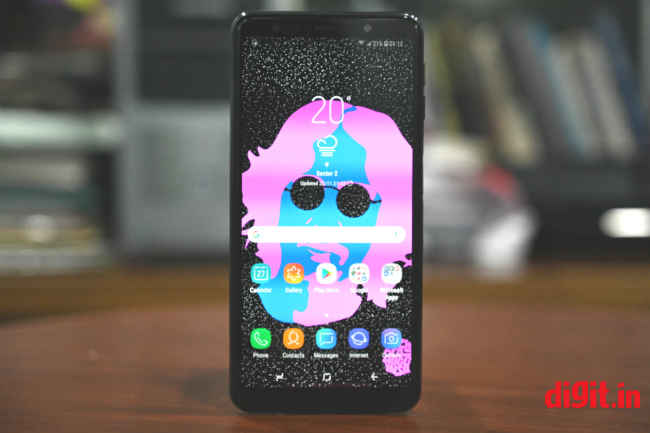
Bright, vibrant AMOLED panel
Samsung also offers the Always-on display that discretely keeps the screen on while showing the clock and incoming notifications. The lack of notch means there’s no arbitrary cropping in videos or games or even while looking at an image you’ve taken or while reading an article. There’s a night mode that turns on the blue light filter to help you sleep better.
The display is large enough to let you enjoy watching movies and videos on it. It’s also a good screen to read on. Videos on YouTube can be stretched to fill up the screen, else thick letterboxing is present on all sides. Netflix and Amazon Prime Video doesn’t support the new aspect ratio, yet. It’s also Widevine L1 certified which means you stream content from Netflix and Amazon Prime in high definition.
The display is one of the best part about owning this phone. I believe, even more than cameras, it’s this panel that should be the reason to buy this phone.
Performance
Just like in case of the display, the Galaxy A7 (2018) relies on Samsung’s proprietary technology for the performance under the hood. It is powered by Samsung’s own octa-core Exynos 7885 chipset. It’s manufactured on a 14nm manufacturing process and houses two Cortex-A73 cores clocked at 2.2GHz and six Cortex-A53 cores clocked at 1.6Ghz. Samsung promises a giant 75 percent boost in performance over its predecessor, the Exynos 7880, which is corroborated in our benchmark reports.
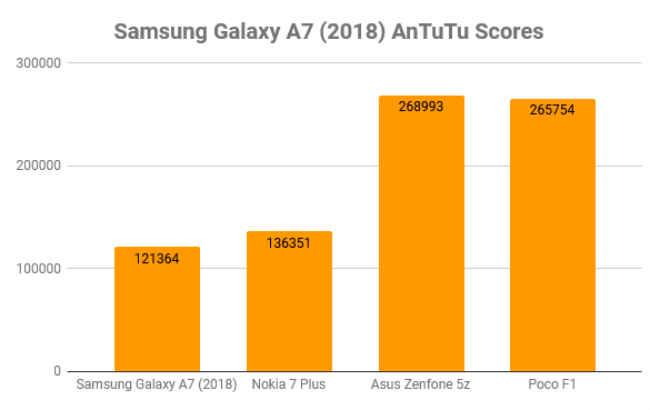
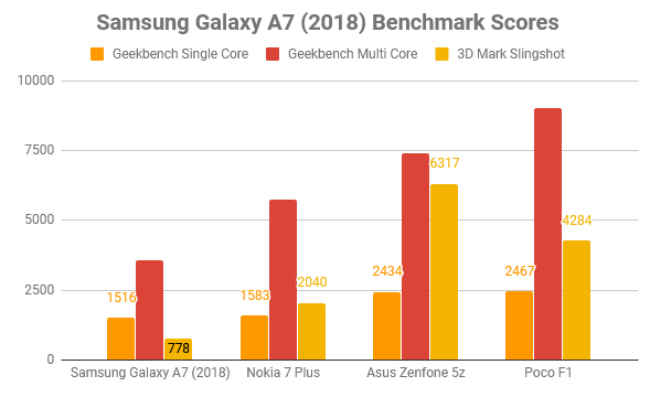
On AnTuTu 7.0, the Samsung Galaxy A7 (2018) scored 121364 against the Poco F1’s 265754. The massive difference in the score is for the fact that the Poco F1 is powered by the Snapdragon 845 chipset, the same that powers the Galaxy Note 9 in select markets. With that looming over the Galaxy A7’s head, it’s difficult to recommend the phone if you’re looking for pure performance. On Geekbench Single Core, the Samsung Galaxy A7 scored 1516 while on multi-core test, it scored 3583. Once again, the scores are nowhere close to what the Poco F1 offers. However, if you are looking for parity, the Nokia 7 Plus scored similarly on the single-core test, but on multi-core, the Snapdragon 660 powering the Nokia 7 Plus outscored the Galaxy A7 (2018) indicating the multi-tasking on the Android One phone might be better. On 3DMark Slingshot, the Mali G71-MP2 GPU on the Galaxy A7 scored just 778 against the Nokia 7 Plus’ 2040 and Poco F1’s 4284. As far as graphics rendering is concerned, this isn’t the best phone to do so.
Looking at the benchmark scores, it seems the Samsung Galaxy A7 (2018) isn’t the most powerful device in its price segment by any means. But as far as real world usage is concerned, the Galaxy A7 (2018) is fairly reliable. There are stutters while launching apps, especially when switching over to another app by double tapping the recent button. The Samsung Experience UI is packed with a whole lot of features and while that’s good for enthusiasts, it also means it will take a hell lot of time for updates to arrive since it takes a long time for beta-testing.
The Samsung Galaxy A7 (2018) can handle games like Angry Birds, Asphalt 8: Airborne with ease, but heavy games like PubG Mobile cannot run smoothly. There were noticeable frame drops and even the power consumption was quite high as the battery percentage went down from 64 to 51 in a 15-minute session.
The Galaxy A7 (2018) is purely focused on the camera, it seems, to the point that the performance is ignored. With options like the Poco F1 and the Nokia 7 Plus which are all-rounders in their own way, the Galaxy A7 (2018) didn’t manage to convince me, when it came to performance.
Camera
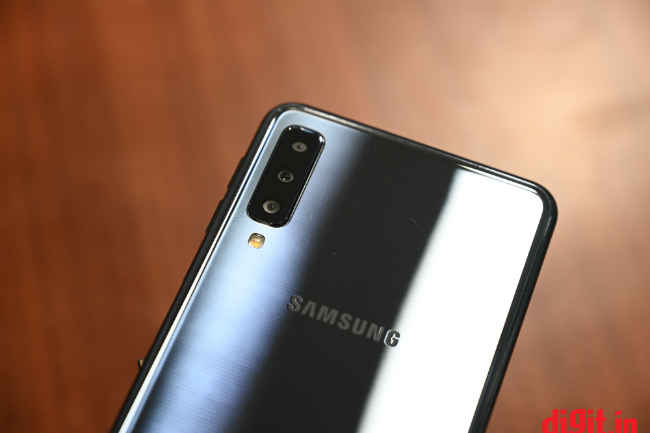
The Samsung Galaxy A7 offers a triple camera setup for the budding photographer
Like we mentioned before, the reason for the Galaxy A7 (2018)’s existence is the rear-camera setup on the back of the phone. Samsung has centered all its marketing around this one feature claiming it’s a new way to see the world. That’s partly true since it’s the first time a Rs 23,000 is sporting a wide-angle camera.
For what it’s worth, there really is a lot going on in the phone’s imaging stack. There is a 24-megapixel primary sensor that can bin four pixels into one for better low-light photos. It has an aperture of f/1.7. Then there is an 8MP, 18mm wide sensor with f/2.4 aperture. It doesn’t have auto-focus and focus is set to infinity. Lastly, there is a 5MP depth sensor for semantic image segmentation to enable portrait mode.
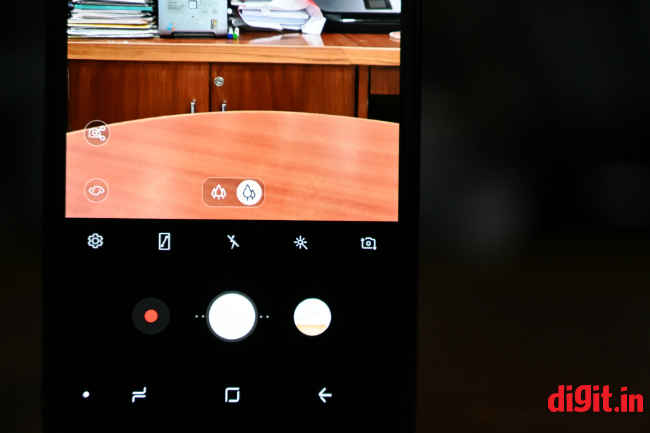
You tap on the icon in the middle to switch between lenses
Here’s how the camera performs:
Wide-angle camera

Poor dynamic range means shadows have next to no details

Closeups come out nice though

Lacks sharpness, but manages to get the exposure right
The primary 24MP sensor manages to take some compelling photos in the day time. The photos appear sharp with added saturation in the colours. However, the camera seems to expose for the highlights more. As a result, shadows come out quite dark. The colours are also a little too saturated with a preference for warmer white balance. It does have good reproduction of details. Close-up shots of flowers have the details intact. However, in landscape shots, the edges come out a little blurred. In low light, the primary sensor uses pixel binning to enhance the details. It’s difficult to say whether it’s the wide f/1.7 aperture or the pixel binning that leads to decent low-light images, but it does work. To be frank, though, the Nokia 7 Plus seems to do a better job at taking low-light shots.
Ultra-wide camera
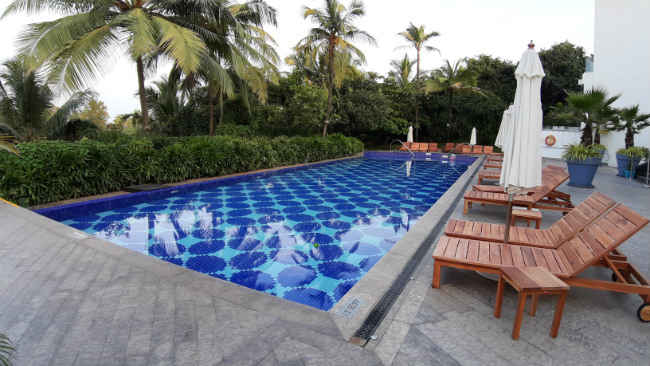
Ultra-wide angle camera comes handy when there’s a lot to cram into a frame
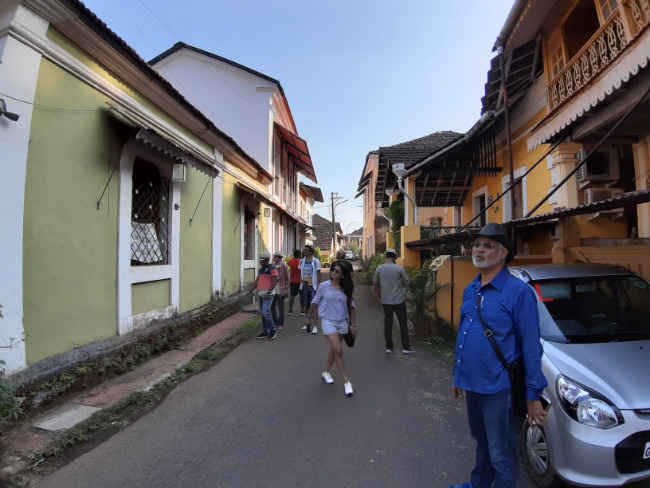
What’s a straight line?

Generic touristy photo
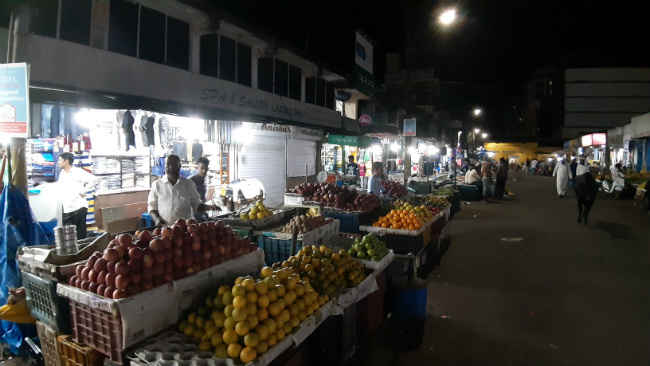
Clipped highlights, dark shadows, but overall a sharp photo with lot of details

Not always, though
The 8MP ultra-wide camera is the big highlight of the Galaxy A7 (2018). While it does offer a wide 120-degree field of view, the camera is focused at infinity. That’s a bummer considering you cannot change the area of exposure and will have to make do with highlight clipping and low dynamic range in the final JPEG in the day-time. Under ideal circumstances though, it manages to pack a lot more objects in the frame as compared to the regular wide-angle lenses people use. The barrel distortion, however, is more than what we have seen in other wide-angle cameras on phones this year. The Asus Zenfone 5z manages to do a much better job at it while the LG G7+ ThinQ produces even better results. In low-light though, the ultra-wide angle camera is practically useless. A small aperture of f/2.4 with no such thing as pixel binning means there’s very little light falling on the sensor. If at all you have to take the sweeping wide shots, it’s better to do it before sunset.
Portrait Mode

Crisp portrait with consistent, natural background blur

Subject almost perfectly separated from the background
The portrait mode on the Samsung Galaxy A7 (2018) is more convincing though. That’s where the third lens comes in. The portrait mode offers you the ability to adjust the amount of depth you want both while shooting and after. And the blurring, when the slider is somewhere in the middle, is pretty consistent and looks natural.
There’s also the scene optimiser mode that Samsung claims uses machine learning to determine what you’re shooting and adjust the camera parameters accordingly. It’s simply Samsung pandering to the people who have started to like phones by Honor, Vivo, Oppo and Xiaomi. The Chinese manufacturers use this feature to market their smartphones, and it seems Samsung wanted a piece of that cake. It doesn’t seem all that useful though, and you’re better off shooting in the normal mode.
There is also a pro-mode but it doesn’t offer a wide suite of options like the ones found in Samsung’s flagships. You can cannot switch between lenses for one and there’s no way to change shutter speeds. You can only play around with an exposure compensation meter, ISO, metering and White Balance. For a phone where the camera is the primary highlight, this might not sit well with the people.
Battery
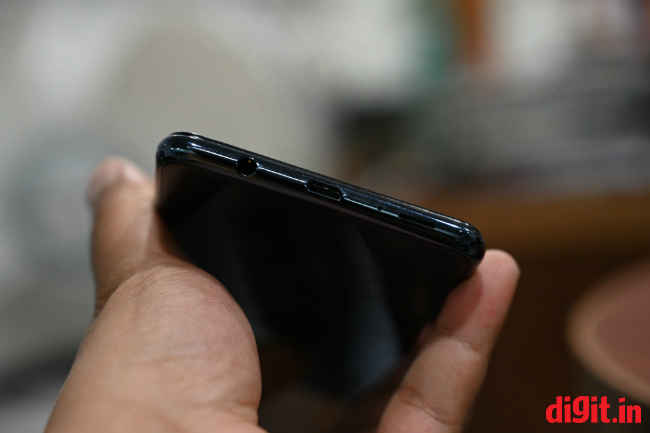
Why are micro-USB ports still mainstream in 2018?
The Galaxy A7 (2018) packs a 3,300mAh battery under the hood. The capacity might seem less as compared to other offerings in that price range, but thanks to a power-efficient chipset and an AMOLED display, the phone manages to eke out around 6 hour of screen-on time on PC Mark’s Work 2.0 battery test. It should easily convert to a day’s worth of usage. We used the phone to mainly shoot a lot of photos, post on social media and a little bit of gaming and it lasted till around 8 PM in the evening. There is no option to quick charge the phone and it takes well over an hour and a half to top up the battery. While we have seen phones with longer battery life, the Galaxy A7 (2018) isn’t all that bad with its usage. The software seems to be well optimised to save power.
Bottomline
The Samsung Galaxy A7 (2018) may consider itself a standout smartphone in that price-range purely for packing more than two cameras on the back, but there’s more to the phone than a triple-camera setup. It certainly brings on board a whole lot of features borrowed from its flagships, but as far as the performance is considered and how well the features work, it doesn’t live up to the hype. What the phone offers is a choice to the user. While there are phones that can either take good photos using the primary sensor like the Nokia 7 Plus. Or it can take a good enough wide-angle shot, like the Asus Zenfone 5z. Or take good portraits like the Poco F1. The Samsung Galaxy A7 (2018) offers all three options and for the most part, manages to do it decently enough.
[ad_2]
Source link





